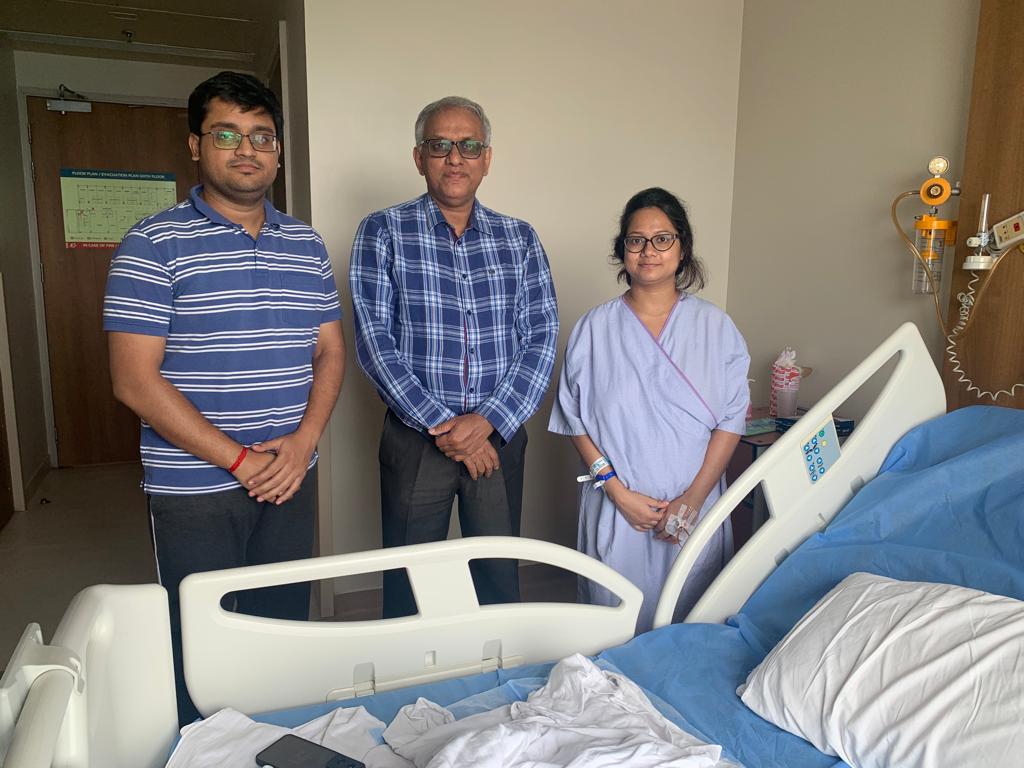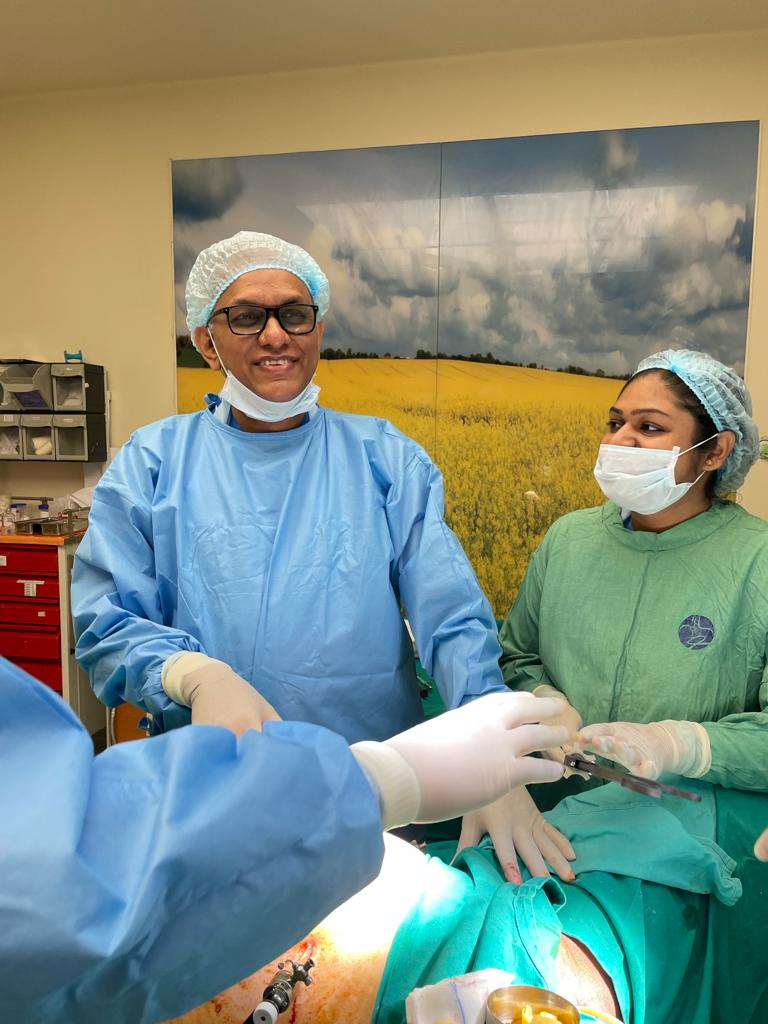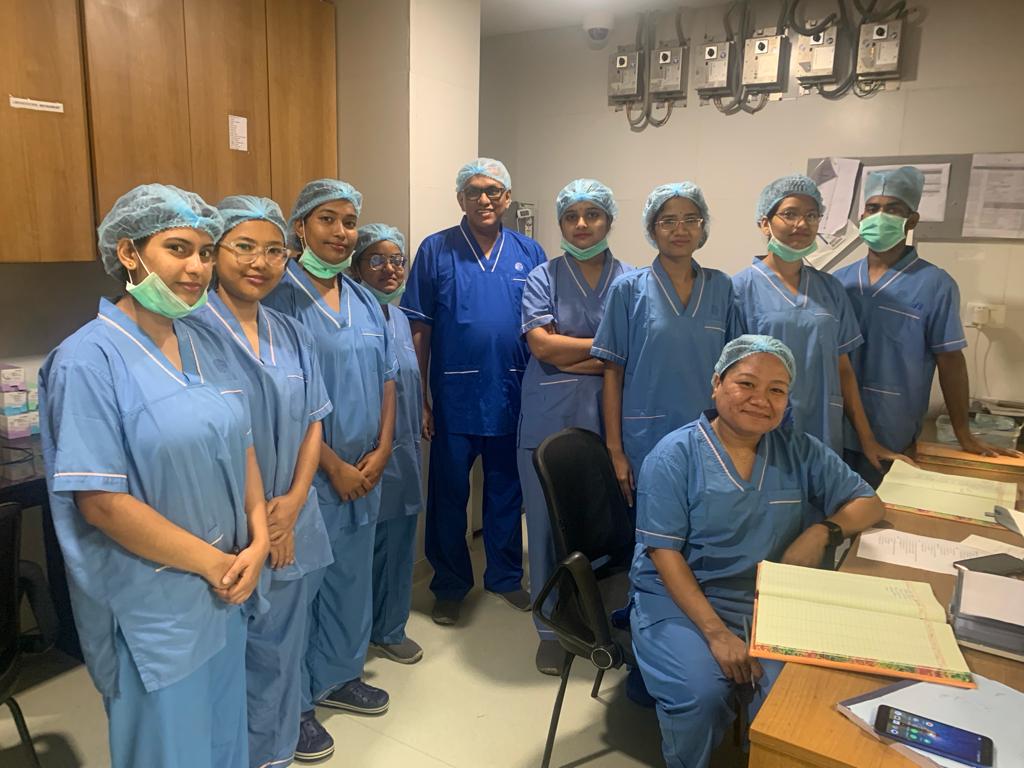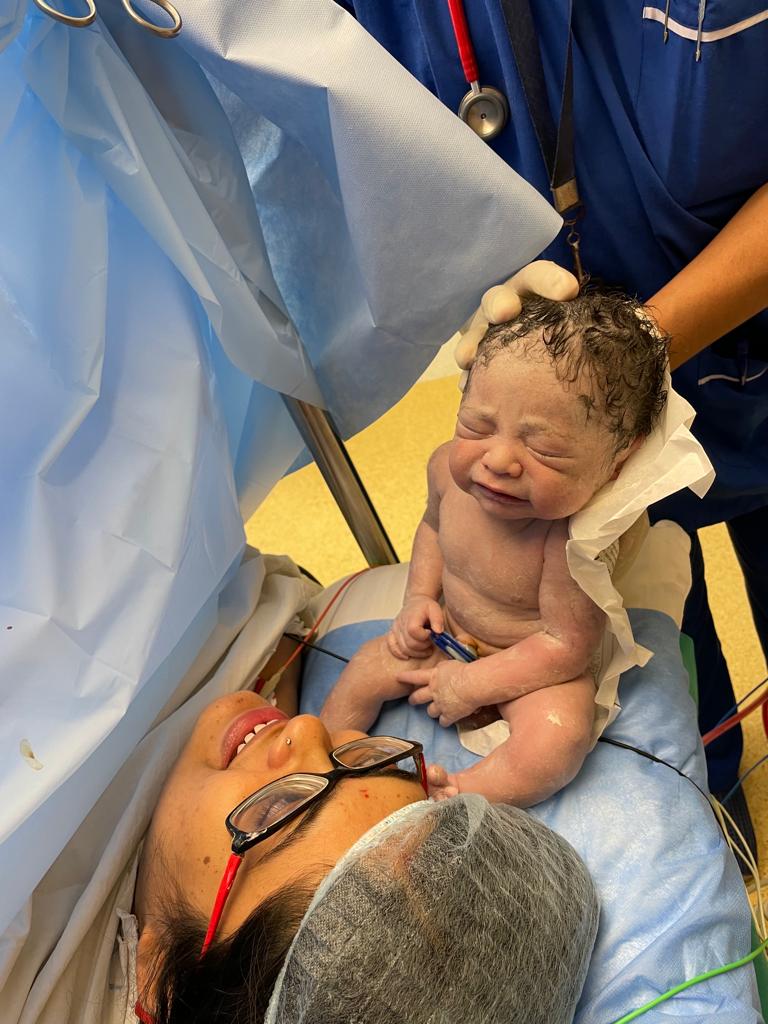
Best Gynaecologist & Obstetrician Doctor in Salt Lake, Kolkata
Dr. Dasmahapatra’s educational background is impressive. He obtained his Bachelor of Medicine and Bachelor of Surgery (M.B.B.S) degree from Nil Ratan Sirkar College and Hospital, Calcutta. Following that, he pursued further specialization in gynecology & obstetrics, earning a Master of Science (M.S) degree from Patna University in 1993.

To enhance his expertise in the field of gynecological surgery, Dr. Dasmahapatra pursued a Fellowship in Gynecological Endoscopic Surgery from Sydney, Australia. This fellowship is highly regarded, particularly in the realm of cutting-edge laparoscopic surgery procedures, which indicates his commitment to staying at the forefront of advancements in his field. This additional qualification from an esteemed institution like Sydney, Australia, is likely to provide him with a significant advantage in delivering advanced surgical techniques and treatments to his patients.
Treatments
-
Laparoscopic Surgery in Infertility
Laparoscopic surgery plays a significant role in the management of infertility, particularly in cases where there are anatomical abnormalities or conditions that affect reproductive organs. Here’s how laparoscopic surgery is utilized in infertility treatment:
- Diagnosis: Laparoscopy allows for a direct visualization of the pelvic organs, such as the uterus, fallopian tubes, and ovaries. This enables the surgeon to identify any abnormalities such as endometriosis, pelvic adhesions, fibroids, ovarian cysts, or tubal blockages that may be contributing to infertility.
- Treatment of Endometriosis: Endometriosis, a condition where the tissue that lines the uterus grows outside of it, can cause infertility. Laparoscopic surgery can be used to remove endometrial implants and scar tissue, improving fertility outcomes.

- Tubal Evaluation and Repair: Laparoscopy can be used to assess the patency (openness) of the fallopian tubes. If blockages are identified, they can often be surgically corrected during the same procedure, potentially restoring fertility.
- Treatment of Ovarian Cysts: Ovarian cysts can sometimes interfere with ovulation and fertility. Laparoscopic surgery can be utilized to remove cysts while preserving ovarian function, thus improving fertility potential.
- Fibroid Removal (Myomectomy): Uterine fibroids can affect fertility by interfering with implantation or causing distortion of the uterine cavity. Laparoscopic myomectomy allows for the removal of fibroids while preserving the uterus, which is crucial for future fertility.
-
Caesarean Section
A Caesarean section, commonly referred to as a C-section, is a surgical procedure used to deliver a baby through an incision made in the mother’s abdomen and uterus. This procedure may be planned in advance (elective) or performed as an emergency measure if complications arise during labor.

Here’s an overview of the reasons why a Caesarean section might be recommended:
- Failure to Progress in Labor: If labor is not progressing as expected, and the cervix is not dilating or the baby is not descending through the birth canal, a C-section may be necessary to safely deliver the baby.
- Fetal Distress: If signs of fetal distress are observed during labor, such as an abnormal fetal heart rate pattern indicating that the baby is not tolerating labor well, a C-section may be performed to expedite delivery and prevent harm to the baby.
- Malpresentation: If the baby is not in the optimal head-down position for delivery (vertex presentation), such as breech (buttocks or feet first) or transverse (sideways) position, a C-section may be recommended to avoid complications during vaginal delivery.
- Placenta Previa: In cases where the placenta partially or completely covers the cervix, a condition known as placenta previa, vaginal delivery can be dangerous and may result in severe bleeding. A C-section is typically the safest method of delivery in such cases.
- Previous C-section: Women who have undergone a previous C-section may require a repeat C-section for subsequent deliveries, particularly if they have a vertical incision on the uterus or other factors that increase the risk of uterine rupture during vaginal birth after C-section (VBAC).
- Maternal Health Conditions: Certain maternal health conditions, such as active genital herpes infection, severe heart disease, or certain types of tumors, may increase the risk of complications during vaginal delivery, making a C-section the safer option.
- Multiple Gestation: In pregnancies involving twins, triplets, or higher-order multiples, a C-section may be recommended if vaginal delivery is not feasible or if there are complications such as fetal malpresentation.
It’s important to note that while Caesarean sections can be life-saving in certain situations, they also carry risks and longer recovery times compared to vaginal deliveries. The decision to perform a C-section is typically made collaboratively between the patient and their healthcare provider, weighing the potential benefits and risks based on individual circumstances. Dr. Dasmahapatra, with his expertise in gynecological and obstetric surgery, would likely be well-qualified to perform Caesarean sections when necessary, ensuring the safety and well-being of both mother and baby.
-
High Risk Pregnancy
A high-risk pregnancy refers to a pregnancy where there is an increased likelihood of complications for the mother, the baby, or both. These complications can arise due to various factors, including pre-existing medical conditions, pregnancy-related conditions, or factors related to the pregnancy itself. Here are some common reasons why a pregnancy may be considered high-risk:
- Advanced Maternal Age: Women who become pregnant at an older age, typically over 35, are at an increased risk of complications such as gestational diabetes, preeclampsia, and chromosomal abnormalities in the baby (e.g., Down syndrome).
- Pre-existing Medical Conditions: Women with pre-existing health conditions such as diabetes, hypertension, heart disease, autoimmune disorders, kidney disease, or obesity are at a higher risk of developing complications during pregnancy. These conditions may require specialized management and monitoring during pregnancy to optimize outcomes for both the mother and baby.

- Previous Pregnancy Complications: Women who have experienced complications in previous pregnancies, such as preterm birth, preeclampsia, gestational diabetes, stillbirth, or miscarriage, are at an increased risk of experiencing similar complications in subsequent pregnancies.
- Multiple Gestation: Pregnancies with twins, triplets, or higher-order multiples are considered high-risk due to an increased likelihood of complications such as preterm birth, low birth weight, and preeclampsia.
- Placental Disorders: Conditions such as placenta previa (where the placenta partially or completely covers the cervix), placental abruption (where the placenta separates from the uterine wall prematurely), or placenta accreta (where the placenta attaches too deeply into the uterine wall) can pose serious risks to both the mother and baby and may require specialized care.
- Fetal Abnormalities: Certain fetal abnormalities or genetic conditions detected during prenatal screening or ultrasound examinations can increase the complexity of the pregnancy and may require additional monitoring and interventions.
- Maternal Lifestyle Factors: Factors such as smoking, alcohol consumption, substance abuse, or inadequate prenatal care can increase the risk of complications during pregnancy and may necessitate closer monitoring and intervention.
- Infections: Certain infections contracted during pregnancy, such as cytomegalovirus (CMV), toxoplasmosis, rubella, or sexually transmitted infections (STIs), can pose risks to the developing fetus and may require specialized management.
Management of a high-risk pregnancy typically involves close monitoring by healthcare providers, including obstetricians, maternal-fetal medicine specialists, and other specialists as needed. Treatment may include medications, lifestyle modifications, specialized prenatal testing, fetal monitoring, and, in some cases, early delivery or interventions to mitigate risks. The goal is to optimize outcomes for both the mother and baby while minimizing complications. Dr. Dasmahapatra’s expertise in obstetrics and gynecology, coupled with his experience in managing complex cases, would likely make him well-equipped to care for women with high-risk pregnancies, ensuring the best possible outcomes for both mother and baby.
-
Normal Delivery
A normal delivery, also known as vaginal delivery, is the process of giving birth to a baby through the vagina. It is the most common method of childbirth and is considered the natural way for a baby to be born when there are no complications that necessitate a Caesarean section. Here’s an overview of what happens during a normal delivery:
- Onset of Labor: Labor typically begins when the mother’s body initiates rhythmic contractions of the uterus, which help to efface (thin out) and dilate (open) the cervix. These contractions may start gradually and become more frequent and intense over time.
- Cervical Dilation: As labor progresses, the cervix dilates to allow the baby to pass through the birth canal. This stage of labor is divided into three phases: early labor (0-3 cm dilation), active labor (4-7 cm dilation), and transition (8-10 cm dilation).
- Pushing Stage: Once the cervix is fully dilated, the mother enters the pushing stage of labor. During this stage, she may feel strong urges to push with each contraction, helping to propel the baby down the birth canal. The healthcare provider will guide the mother on when and how to push effectively.

- Delivery of the Baby: As the baby moves through the birth canal, the healthcare provider assists with the delivery by supporting the perineum (the area between the vagina and anus) and guiding the baby’s head and shoulders out of the birth canal. Once the baby’s head is delivered, the healthcare provider may suction the baby’s mouth and nose to clear any fluids and ensure the baby can breathe.
- Delivery of the Placenta: After the baby is born, the placenta, which provided nourishment to the baby during pregnancy, detaches from the uterine wall and is expelled from the mother’s body. This usually occurs within minutes to hours after the birth of the baby and is typically facilitated by gentle uterine contractions.
- Immediate Postpartum Care: After the delivery, the healthcare team assesses the mother and baby’s condition and provides immediate postpartum care. This may include monitoring vital signs, initiating skin-to-skin contact between the mother and baby, breastfeeding support, and checking for any signs of complications.
- Recovery: Following a normal delivery, the mother will typically spend a brief period of time in the hospital or birthing center for observation and recovery. Most women are able to resume normal activities within a few days to weeks, although it may take some time for the body to fully recover from childbirth.
While a normal delivery is the preferred method of childbirth when there are no complications, it’s important to note that every labor and delivery experience is unique, and not all deliveries progress according to the textbook definition. Healthcare providers are trained to manage various scenarios that may arise during childbirth and to provide appropriate care to ensure the safety and well-being of both mother and baby.
Dr. Sankar Mahapatra is available at Bhagirathi Neotia Hospital Newtown, Kolkata:
Bhagirathi Neotia Woman and Child Care Centre
Address: Premises No. 27-0327, Street No. 327, Action Area 1D, Newtown Kolkata – 700 756 West Bengal, India
Dial: (+91) 87776 13551/ 92306 16647/ 98300 78757
WhatsApp: 98300 78757
Visiting Hours: Monday to Saturday 10 a.m – 11:30 a.m